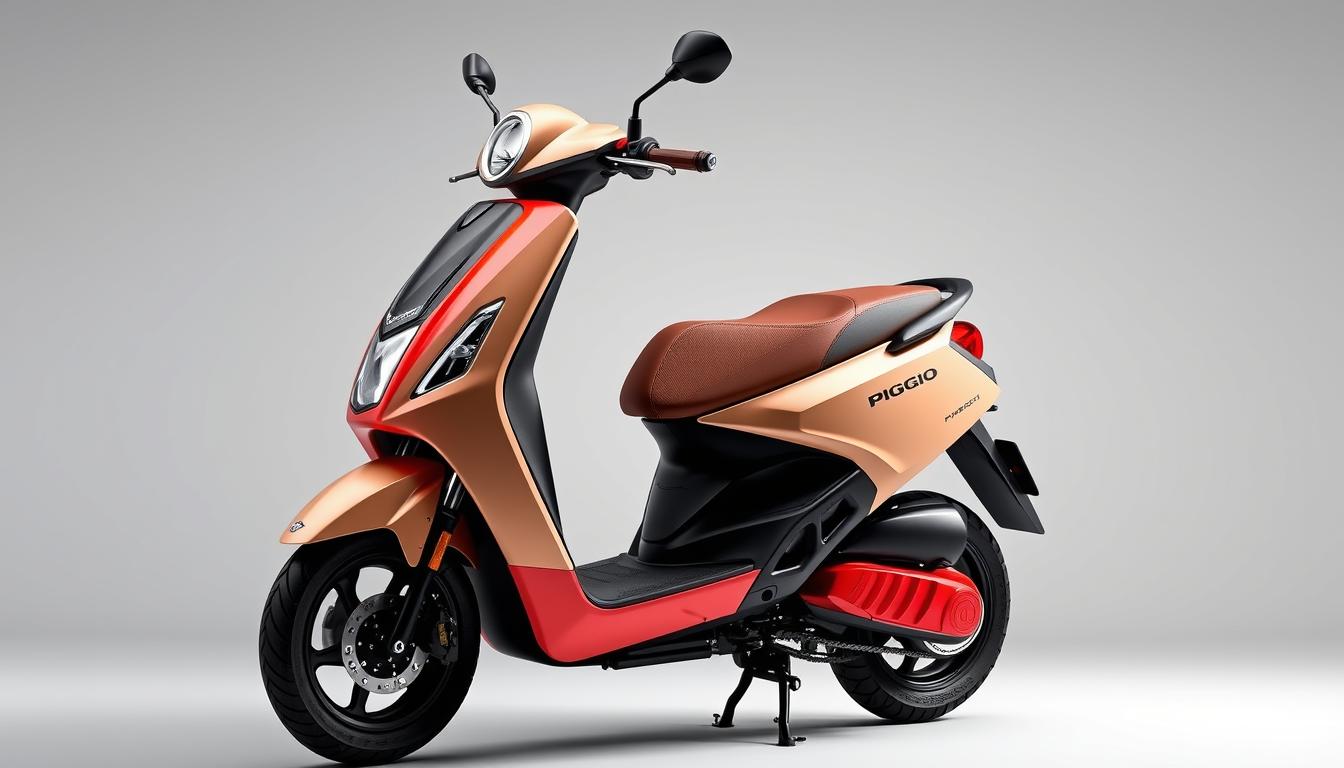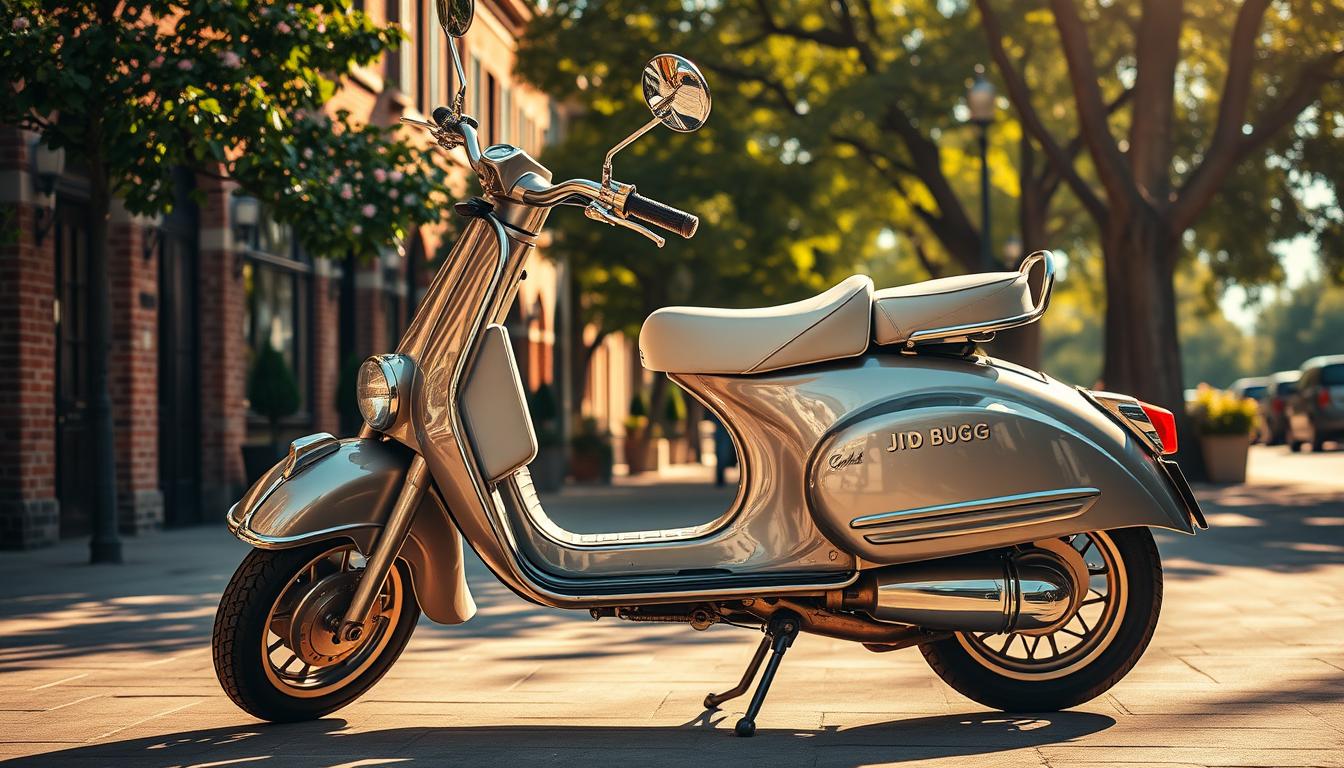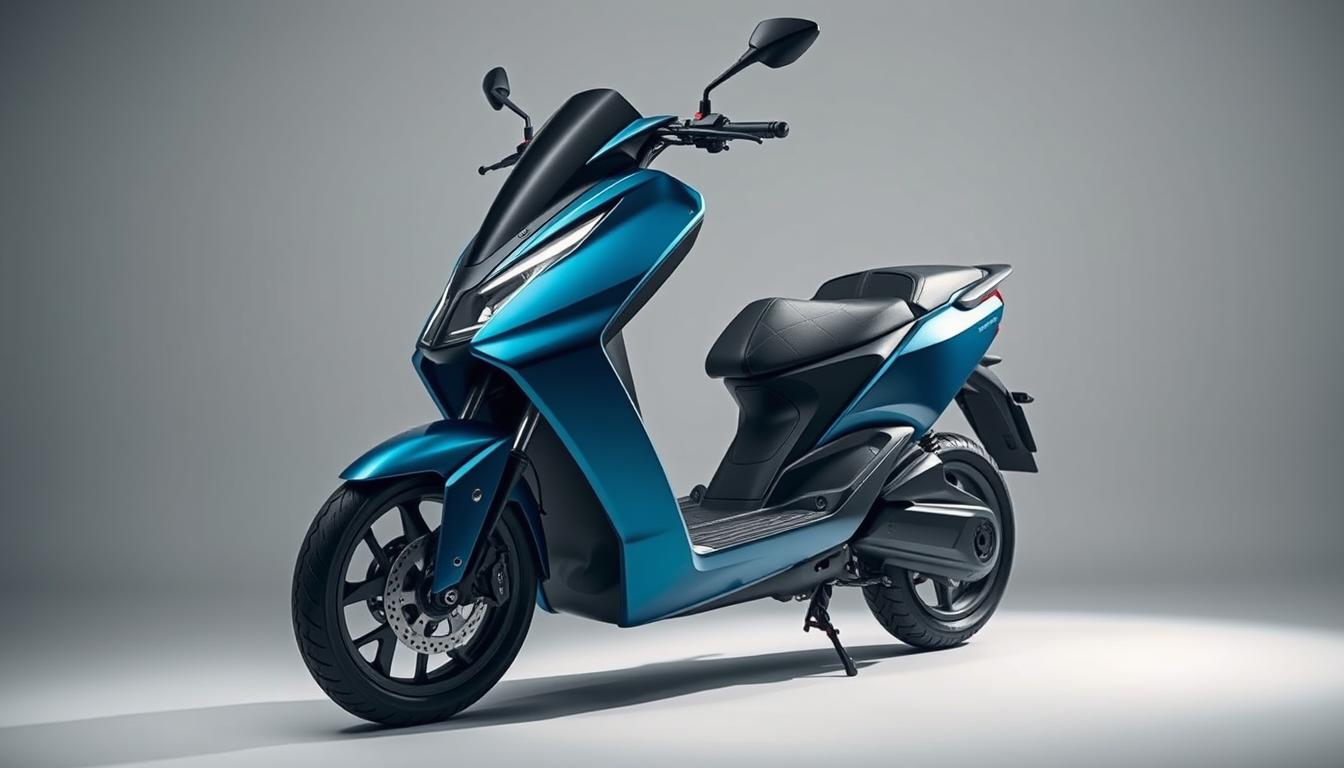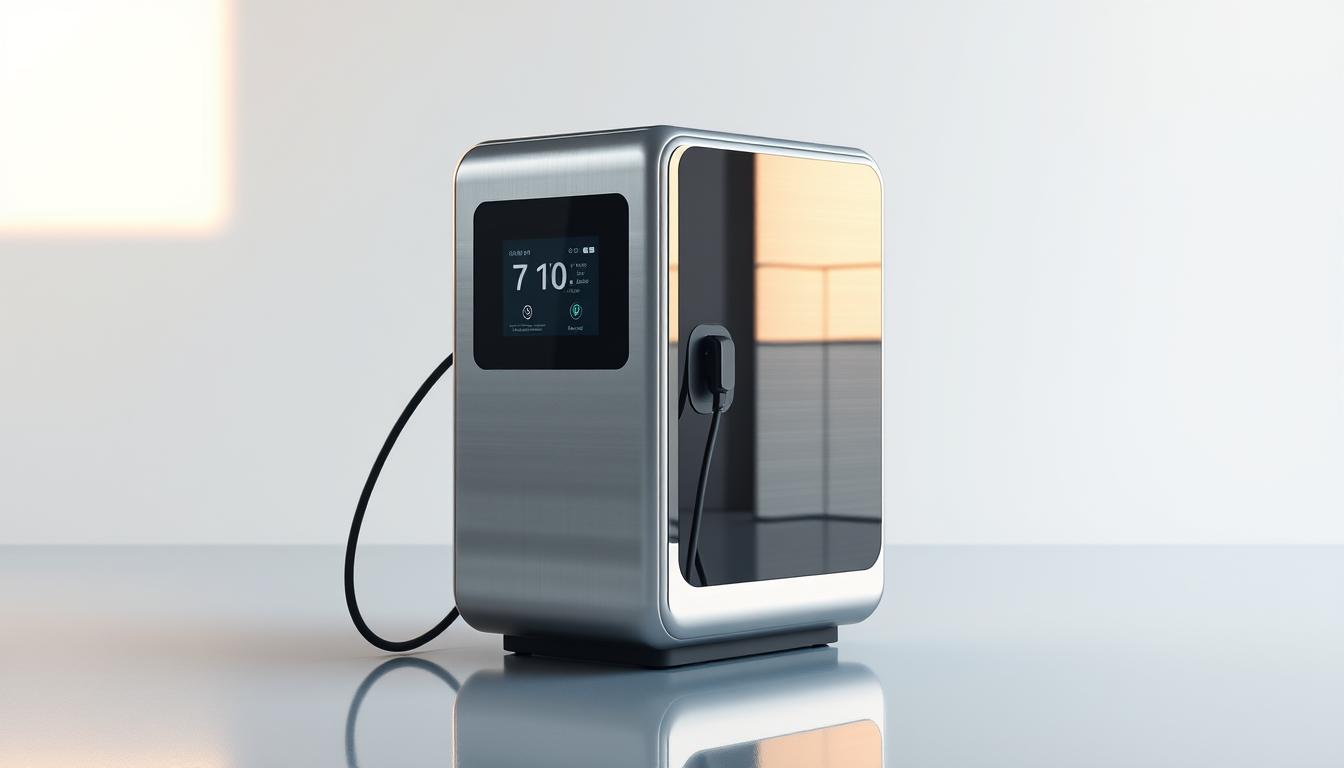
GY6 Motor: A Comprehensive Scooter Engine Guide
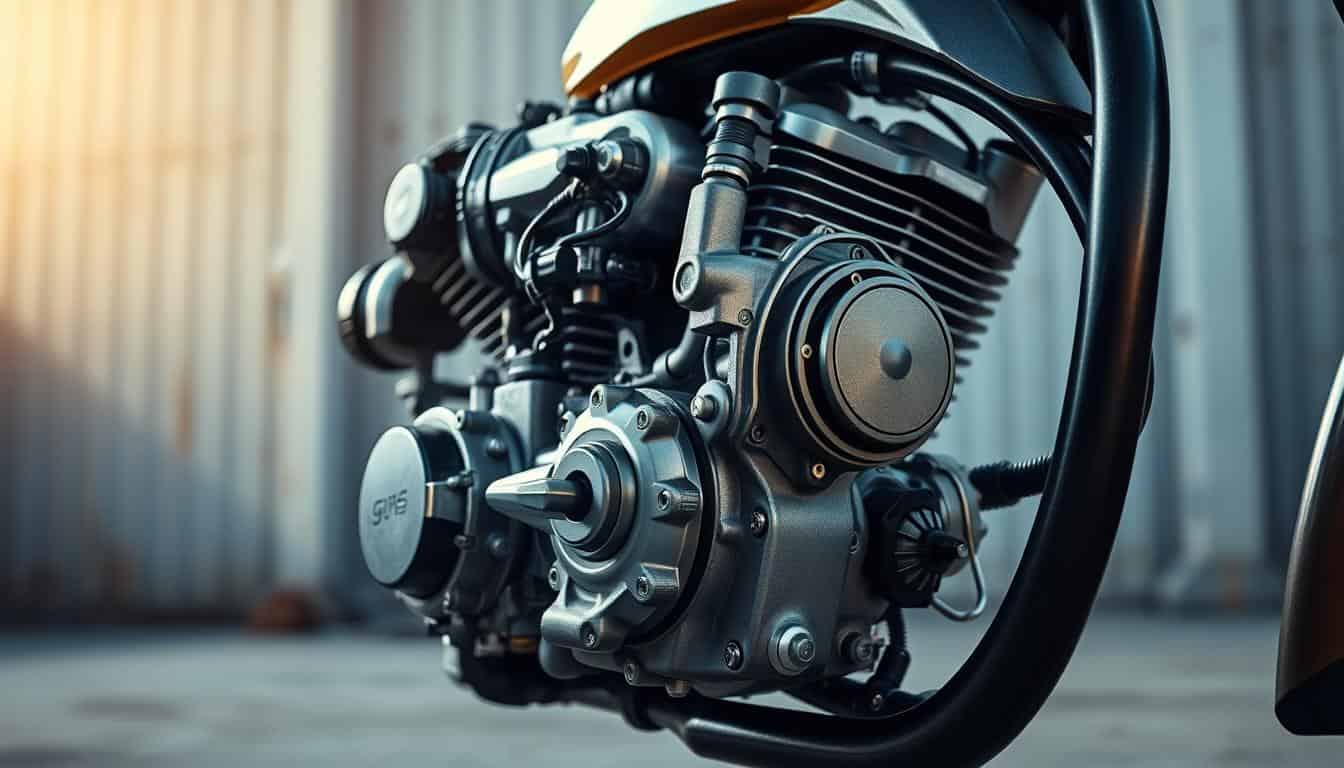
The GY6 engine powers millions of scooters worldwide, known for its durability and versatility. With a 150cc displacement, it delivers smooth performance for daily commutes or weekend rides. Its air-cooled design and efficient fuel consumption make it a top choice for riders.
This guide dives into specs, upgrades, and maintenance tips. Whether tuning for speed or replacing parts, the GY6 platform offers endless customization. Popular models like the Honda Ruckus rely on this reliable engine.
Aftermarket support and easy modifications keep these scooters dominating roads. From beginners to DIY pros, understanding this powerhouse unlocks better rides and longer lifespans.
Understanding the GY6 Motor
Born from Honda’s engineering, the GY6 revolutionized small-engine design. This single-cylinder, air-cooled 4-stroke powerhouse balances durability with simplicity. Its belt-driven CVT transmission and CDI ignition make it a favorite for urban riders.
What Is a GY6 Engine?
The engine features a carbureted fuel system and just two valves, reducing complexity. Ranging from 49cc to 171cc, it adapts to everything from compact 50cc scooters to 300cc custom builds. Mechanics love its minimal electronics, which streamline repairs.
History and Common Applications
Originally designed for Japanese motorcycles in the 1980s, the GY6 later fueled China’s mass-produced scooters. Today, it powers models like the Tao Tao VIP 150 and Ice Bear Maddog. Honda Ruckus swaps often use this engine for its reliability.
Standardized parts make upgrades effortless. Over 80% of U.S. market scooters rely on the GY6 platform. Its blend of affordability and performance keeps it dominant.
GY6 Motor Specifications and Features
Balancing power and simplicity, this engine dominates urban commuting. Its 150cc design blends efficiency with adaptability, making it a top pick for riders. Below, we break down the key specs that set it apart.
Displacement and Bore/Stroke Details
The 57.4mm bore and 57.8mm stroke create a displacement of 149.6cc, rounded to 150cc. This compact build maximizes torque while keeping weight low. Riders enjoy responsive acceleration without sacrificing fuel economy.
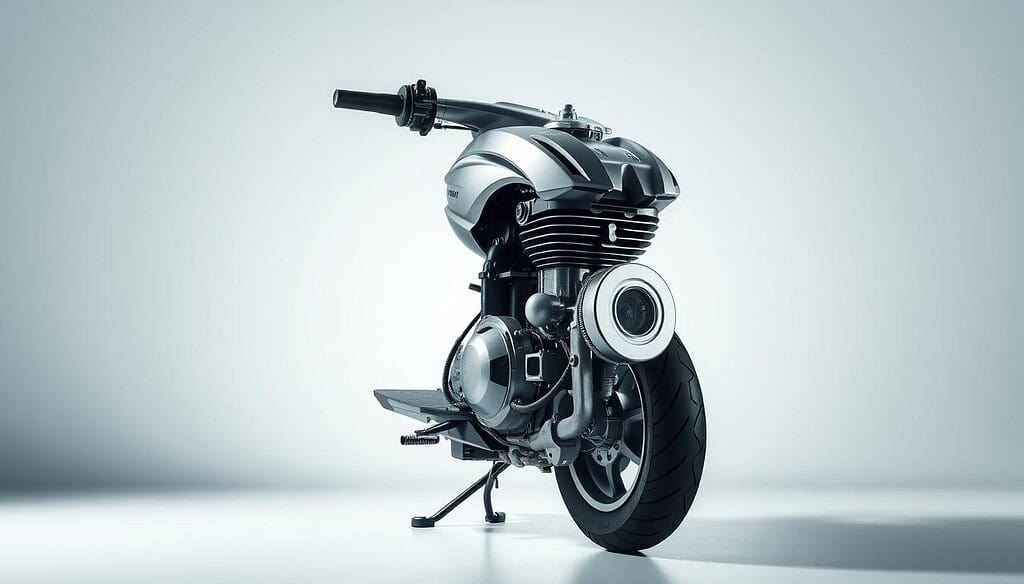
Cooling System and Compression Ratio
An air-cooled design reduces complexity and maintenance. Unlike liquid-cooled engines, it avoids overheating in stop-and-go traffic. The 9.5:1 compression ratio optimizes power while running smoothly on 87-octane fuel.
Fuel Efficiency and Power Output
With 7.3kW (9.8HP), the 150 gy6 pushes 105kg scooters to 53mph. Proper tuning achieves 85mpg, thanks to efficient carburetion and belt drives. This balance of performance and economy keeps riders coming back.
Performance Upgrades for the GY6 Engine
Unlocking extra power from your scooter starts with smart upgrades. The right modifications boost speed, acceleration, and reliability without breaking the bank. From big bore kits to precision-tuned intakes, these tweaks maximize the engine’s potential.
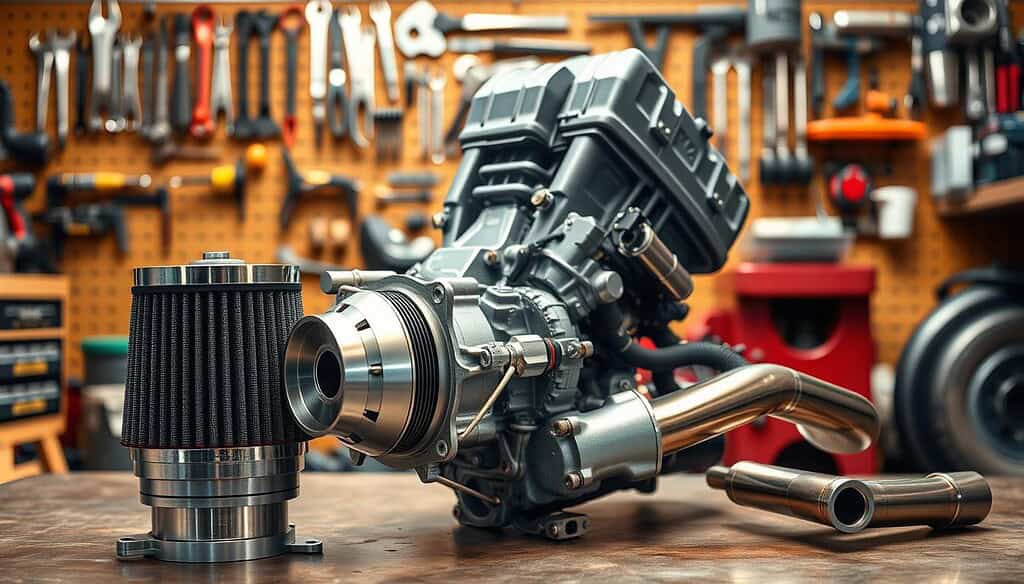
Big Bore Kits: 150cc to 171cc Conversions
The NCY 171cc kit ($159.49) adds 21cc displacement for a 15% power gain. No machine work is needed—just bolt on the larger cylinder and piston. Riders enjoy stronger torque for hills or highway speeds.
Remember to rejet the carburetor after installation. Upgraded clutches handle the extra strain, ensuring smooth performance.
High-Performance Variators and Clutches
Lighter parts mean quicker acceleration. The NCY Golden Variator ($79.49) uses aluminum drive faces to cut rotational mass. Its polished design reduces belt wear, too.
Pair it with reinforced clutch springs for seamless power transfer. The result? Faster throttle response and smoother rides.
Upgraded CDI Boxes and Air Intakes
Remove rev limiters with the NCY 6-pin CDI ($57.99). It adjusts ignition timing for better start-ups and top-end speed. For airflow, PTFE-coated intakes ($67.99) boost combustion by 22%.
These mods work best together. A tuned intake complements a big bore kit, while the CDI unlocks its full potential.
GY6 Transmission and Drivetrain
Behind every reliable scooter ride lies a well-tuned transmission system. The GY6’s belt-driven CVT ensures smooth power delivery, adapting to speed changes effortlessly. Riders enjoy a balance of efficiency and responsiveness, thanks to its smart design.
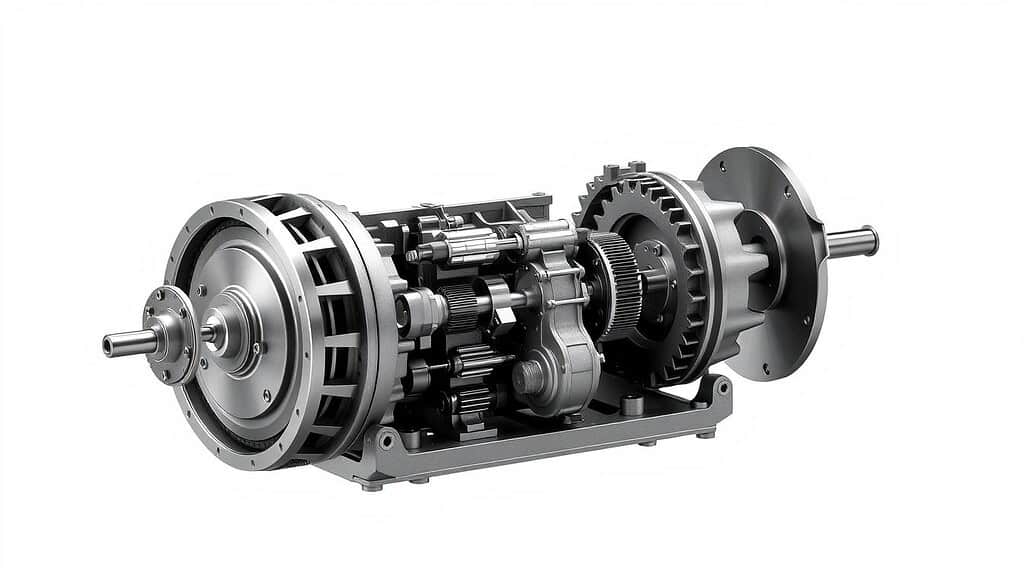
Belt-Driven CVT System
Centrifugal weights—like sliders or rollers—shift the belt’s position to adjust gear ratios. Lighter weights rev higher for quick acceleration, while heavier ones prioritize top speed. The Dr. Pulley 18x14mm sliders ($29.99) excel here, maintaining RPMs during hill climbs.
For reduced friction, the NCY 115mm variator ($40.49) aligns belts precisely. Its aluminum drive face cuts weight, boosting throttle response. Unlike rollers, sliders reduce belt wear, extending lifespan to 5,000 miles.
Lightweight Drive Faces and Sliders
Upgraded components like the NCY aluminum drive face optimize power transfer. Combined with reinforced clutches, they handle extra torque from performance mods. Inspect belts every 500 miles for cracks—early replacements prevent roadside breakdowns.
Some 150cc models include a backup kickstarter for manual start-ups. This failsafe ensures mobility even if the electric ignition falters. Whether commuting or customizing, the GY6’s transmission adapts to every need.
Essential Maintenance for Longevity
Proper maintenance extends the life of your ride and prevents costly repairs. The GY6 engine thrives with routine care, whether you’re commuting daily or tuning for performance. Follow these steps to keep it running smoothly for years.
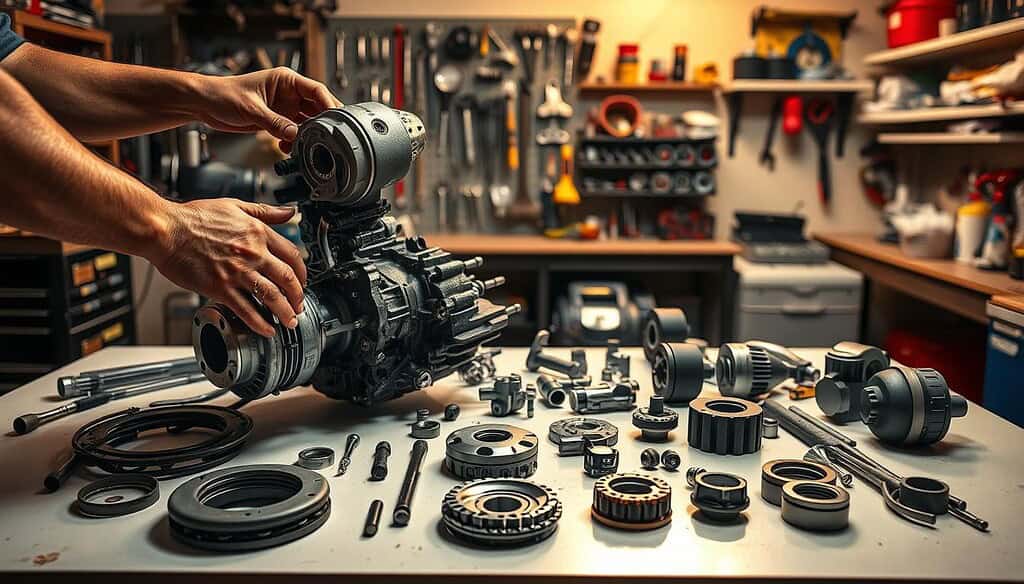
Oil Changes and Cooling System Care
Swap the oil every 1,000 miles using 10W-40 JASO MA2 oil. Fresh lubricant reduces friction and protects internal parts. For the cooling system, clean the fins twice a year to prevent dust buildup.
Avoid frequent short trips—they cause oil coking. If your scooter overheats, check for blocked air vents. European service centers offer 24/7 support for troubleshooting.
Belt and Roller Inspections
Inspect the CVT belt every 500 miles. A healthy belt should measure ≥17mm wide (for 150cc models) and show no glazing. Worn rollers or sliders reduce acceleration—replace them if cracked.
- Use a caliper to check belt width accurately.
- Upgrade to Dr. Pulley sliders for longer lifespan.
Spark Plug and Ignition Checks
The NGK CR7HSA plug gapped to 0.6–0.7mm ensures reliable cold starts. A fouled plug causes hard starting or misfires. Test ignition coils annually, especially if you’ve installed performance parts.
Third-source suppliers back their engine components with a 1-year warranty. Production lead times average 45–60 days, but fast shipping options are available.
Top GY6 Parts and Accessories
The right accessories can transform a standard scooter into a high-performance machine. From displacement-boosting kits to precision monitoring tools, these upgrades maximize power and reliability. Riders can customize their ride while maintaining the engine’s renowned durability.
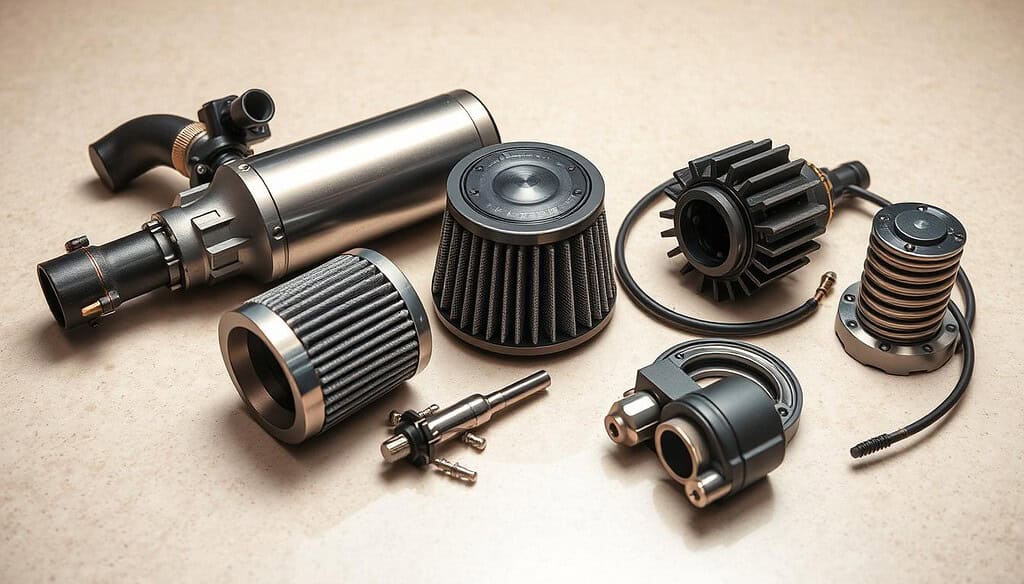
NCY Big Bore Kits and Cylinders
For serious power gains, the NCY 171cc kit upgrades the standard 150cc cylinder with OEM-grade cast iron. Its metallurgy reduces piston scuffing, ensuring longevity under stress. At $690.49, the 88cc version offers a more budget-friendly entry point.
Pair these parts with NCY’s free-flow exhausts for a balanced setup. The combo optimizes backpressure, preventing power loss at high RPMs. Always use a torque wrench (12-15ft-lbs) when installing head bolts.
Performance Exhausts and Intakes
Upgraded airflow systems unlock hidden potential. KOSO’s PTFE-coated intakes boost combustion efficiency by 22%, while NCY’s stainless exhausts reduce weight. Together, they sharpen throttle response across all speeds.
Avoid cheap Amazon parts—counterfeit CDIs often lack proper rev limiters. Stick to trusted brands for consistent performance.
Trailtech Gauges for Monitoring
The Trailtech Vapor ($203.99) tracks RPM, coolant temp, and speed via programmable sensors. Its bright display remains visible in sunlight, making it ideal for tuned scooters. For precision tuning, the KOSO EGT gauge ($281.49) monitors exhaust temps in real time.
These tools help diagnose issues before they cause damage. Impact drivers simplify variator nut removal during maintenance.
Common GY6 Engine Issues and Fixes
Even reliable engines like the GY6 can develop problems over time. Recognizing symptoms early saves money and keeps rides smooth. This section covers frequent hiccups—from stubborn start-ups to overheating—and proven solutions.
Common Causes of Hard Starting
A scooter that won’t start often suffers from three issues: weak sparks, clogged fuel jets, or low compression. Test the stator output (≥12V AC at 3,000 RPM) to rule out electrical faults. Dirty carburetor pilot jets are another culprit—flush them with aerosol cleaner.
- Check valve lash: Tight valves hinder combustion. Adjust to 0.004″ (intake) and 0.006″ (exhaust).
- Test fuel delivery: Spray gas into the intake manifold vacuum port. If it starts, clean the carb.
- Backup plans: Models with a kickstarter bypass electrical issues. Keep the mechanism lubricated.
Overheating and Airflow Solutions
Stop-and-go traffic strains the air-cooled design. Upgrade to a 12V 35W cooling fan for better airflow. Install 8° advanced timing keys to reduce heat buildup at high RPMs.
For chronic overheating, inspect the oil strainer screen. Unlike filtered engines, the GY6 relies on frequent oil changes to flush metal particles. Use 10W-40 JASO MA2 oil every 1,000 miles.
Third-party suppliers like ScootDawg’s GY6 engine troubleshooting guide recommend WPS Fire Power batteries ($47.49) for cold-weather reliability. Their 1-year warranty covers refurbished parts.
GY6 Swaps and Custom Builds
Custom builds with the GY6 platform open endless possibilities for scooter enthusiasts. Whether upgrading a vintage ride or boosting performance, this engine adapts seamlessly to various frames. Its standardized design simplifies swaps, making it a top pick for DIY projects.
Compatibility with Popular Scooter Models
The GY6 fits popular models like the Honda Ruckus, Yamaha Zuma 125, and Vespa LX150. For non-standard frames, 10mm steel plate adapters ensure a secure fit. Measure the wheelbase (1280mm) and ground clearance (125mm) for effortless integration.
Tips for Engine Swaps
Reinforce mounts to handle extra torque from performance mods. NCY Lowdown shocks ($153.49) improve stability in lowered setups. For wiring, match 6-pin CDI connectors and add 30A inline fuses near the battery.
Note the 150kg payload limit—reinforce rear racks if carrying passengers. Third-party suppliers confirm compatibility with HH150T chassis, ensuring a smooth transmission setup. With these tweaks, your custom build will ride like a dream.
Where to Buy Reliable GY6 Parts
Finding quality GY6 components doesn’t have to be a hassle. Trusted U.S. retailers stock everything from performance kits to essential maintenance parts. Whether upgrading or repairing, these shops offer genuine parts with solid warranties and fast shipping.
Trusted Retailers and Online Shops
ScooterSwapShop leads the pack with NCY, Trailtech, and Dr. Pulley inventory. Their flat-rate shipping and U.S. warehouse ensure quick delivery. For bulk orders, Gy6Racing.com waives shipping fees on purchases over $500 (engines excluded).
For budget-friendly options, Check this U.S.-based seller with a 4.9-star rating and 14-day returns. Avoid AliExpress—70% of bearings fail within six months.
Shipping and Warranty Tips
Always compare coverage: NCY offers 90-day warranties, while Trailtech’s lasts a year. Bundle orders to hit free shipping thresholds. Pro tip: Track production lead times (45–60 days for third-party parts) to avoid delays.
- Verify sellers: Look for detailed product photos and return policies.
- Plan ahead: Order gaskets and seals with performance kits to save on shipping.
Why the GY6 Motor Dominates the Scooter Market
Affordable yet powerful, this platform reshaped urban mobility. With production costs as low as $289, it fuels sub-$1,000 scooters, making it a budget-friendly choice. Identical bearings across 50cc to 250cc models simplify repairs, saving riders time and money.
Six Chinese factories produce 800,000+ units yearly, serving 120 countries. CE/TUV certifications ensure quality, while European warehouses streamline shipping. The U.S. aftermarket thrives too, with $47M in performance parts sold annually.
Though 2030 emissions rules may phase out carbureted models, demand for EFI conversions will keep this engine relevant. Its blend of cost, simplicity, and global support cements the GY6’s legacy.
FAQ
What is a GY6 engine?
The GY6 is a popular four-stroke scooter engine known for its reliability and ease of modification. It’s widely used in 50cc to 150cc models and is a favorite for performance upgrades.
What are the benefits of a big bore kit?
A big bore kit increases displacement, boosting power and torque. Upgrading from 150cc to 171cc enhances acceleration and top speed without major engine modifications.
How often should I change the oil in my GY6 engine?
Regular oil changes every 1,000 to 1,500 miles keep the engine running smoothly. Synthetic oil is recommended for better performance and longevity.
What causes hard starting in a GY6 motor?
Common issues include a weak battery, clogged carburetor, or faulty spark plug. Checking these components first can often resolve the problem.
Are GY6 engines compatible with all scooters?
While adaptable, not all models support a direct swap. Compatibility depends on frame size, mounting points, and electrical connections.
Where can I buy quality GY6 parts?
Reputable retailers like ScooterPartsCo and Rolling Wrench offer genuine components with warranties. Always check shipping policies before ordering.
How can I improve my GY6 engine’s cooling?
Upgrading to a high-flow air intake and ensuring proper airflow around the cylinder helps prevent overheating. An oil cooler is another effective option.
What’s the best exhaust for a performance GY6 build?
Systems from Yoshimura or NCY provide better flow and weight reduction. A tuned exhaust boosts horsepower while maintaining a smooth ride.
Do GY6 engines come with electric and kick start?
Most models include both options. If the electric start fails, the kick starter serves as a reliable backup.
How do I know if my CVT belt needs replacement?
Cracks, fraying, or slipping under acceleration are clear signs. Inspect the belt every 3,000 miles to avoid sudden failures.

